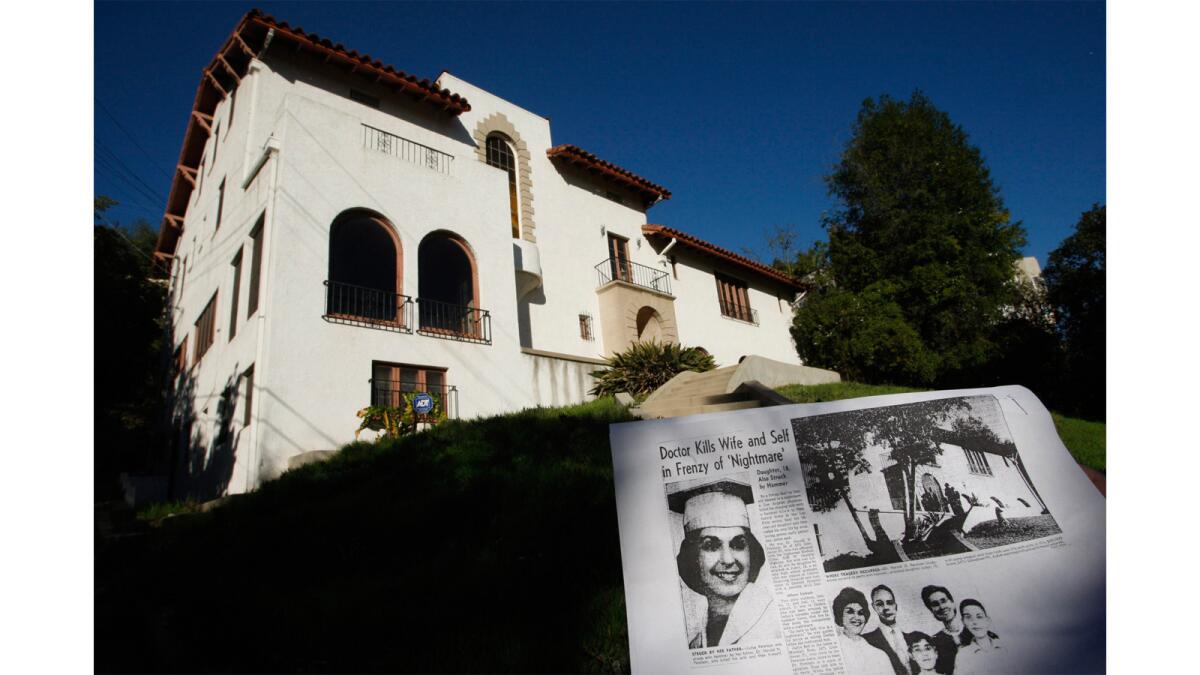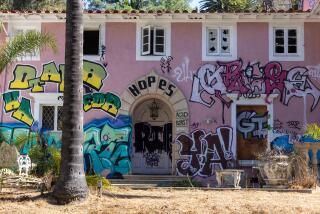On a Los Feliz hill, murder — then mystery

This article was originally published in 2009. The property is now up for sale.
It’s a murder mystery that has puzzled a Los Feliz neighborhood since 1959.
The criminal-case part was solved quickly enough. Homicide investigators found that Dr. Harold Perelson bludgeoned his wife to death with a ball-peen hammer, savagely beat their 18-year-old daughter and then fatally poisoned himself by gulping a glass of acid.
Authorities removed two other children from the sprawling hillside estate that overlooks downtown Los Angeles, locked the front door to the 5,050-square-foot mansion, and left.
Fifty years later, the Glendower Place home remains empty.
The estate’s terraced grounds are pockmarked by gopher holes and overgrown with grass that sprouted after recent rains — growth that neighbors know will turn brown when summer returns. A pond is partly filled with rainwater. Weeds poke through cracks in a curving asphalt driveway.
On the outside, the mansion itself appears to be slowly decaying.
Through grimy, cracked windows, one can see dust-covered furniture, including a 1950s-style television set, seemingly frozen in time. What appear to be gaily wrapped Christmas gifts sit on a table.
And in the hills near the Greek Theatre, the questions linger:
Why has the current owner kept the home as it was on Dec. 6, 1959? Will another family ever again bring life to the estate once described in a sales ad as “beautiful” and “delightful”?
Built in 1925, the three-story Spanish revival-style home has a basement that boasts a maid’s quarters. The first floor features an entrance hall flanked by a glassed-in conservatory and large living room. Toward the back is a den, a dining room and the kitchen.
Four master-bedroom-size sleeping chambers are on the second floor. A bar-equipped ballroom measuring 20 feet by 36 feet is on the third level.
Real estate experts have suggested that the mansion, with its spectacular view of the Los Angeles Basin and the Palos Verdes Peninsula, could fetch as much as $2.9 million if sold.
“No one has lived there since the murders,” said Dr. Cheri Lewis, who grew up across the street from the mansion and still lives in the neighborhood.
Lewis vividly remembers the predawn morning when Perelson, 50, killed his 42-year-old wife, Lillian, and severely beat his teenage daughter.
When two younger children were awakened by the victims’ screams, Perelson told them they were simply having a bad dream, his youngest daughter told police. “Go back to bed. This is a nightmare,” he told 11-year-old Debbie. She and her 13-year-old brother, Joel, escaped injury.
Eighteen-year-old Judye Perelson ran from the mansion and staggered to a neighbor’s house. She was treated at Central Receiving Hospital and then taken to General Hospital with a possible skull fracture, The Times would report the next day.
“Judye came to our door. I remember having my hand in her blood,” recalls Lewis, now a Beverly Hills dentist.
“I used to baby-sit the children there. I was supposed to spend the next night there, in fact.”
Police found Perelson lying dead on the floor next to his wife’s blood-soaked bed. He was still clutching the hammer. On a nightstand next to his bed, investigators found an open copy of Dante’s “Divine Comedy,” which was opened to Canto 1.
“Midway upon the journey of our life I found myself within a forest dark, for the straightforward pathway had been lost . . . ,” read the passage.
Detectives speculated that Perelson, a physician affiliated with an Inglewood medical clinic, was distressed by financial difficulties.
In Judye Perelson’s sports car, police found a note written to an aunt that told of the family being “on the merry-go-round again, same problems, same worries, only tenfold. My parents, so to speak, are in a bind financially.” The teenager spoke of getting a job to help the family out.
After the rampage, relatives took the younger Perelson children to the East Coast, Lewis said. The current whereabouts of the three are unknown.
The story of the murder-suicide and the locked-up mansion has been told and retold ever since, each time a newcomer moves into the neighborhood or when visitors come upon it.
House painter Steve Kalupski was puzzled one summer day eight years ago when he glanced over at the mansion from a neighboring dwelling where he was working. Through a grimy window, he said he could see gifts piled next to what in the dimness appeared to be a Christmas tree.
“I asked the owner of the home where we were working why it was there, and she told me the story,” said Kalupski, a Hollywood resident who now is an ad agency producer.
His friends didn’t believe him when he told them what he’d seen. So he began a ritual of driving them to the Los Feliz hillside to show them the abandoned mansion. He took Hollywood Internet entrepreneur Babette Papaj there two months ago. “It was dark and scary. I was afraid to get out of the car,” she said.
Neighboring Glendower Place resident Sheree Waterson said a friend of hers tried one night to check out the mansion in what she describes as “a Nancy Drew moment.”
The woman pushed open a rear door and walked in, but she didn’t get far before a burglar alarm went off. She turned around and left, joking later about “ghosts” when she returned to Waterson’s home. Soon, her hand was throbbing painfully.
“She’d been bitten by a black widow. There was a red vein going up her arm. She had to go to the doctor,” said Waterson, a clothing company executive.
“Two nights later the alarm kept going off at my house on my back door. But there was no one there. It was like the ghost was following us.”
A year after the murders, in 1960, the mansion was sold in a probate action to a Lincoln Heights couple, Emily and Julian Enriquez. Neighbors remember that the pair visited the house and brought property there to store but didn’t move in.
In time, the place gradually fell into disrepair. Antique light fixtures dating from the 1920s disappeared from the outside.
Over the years, neighbors say they have helped maintain the property by painting a street-side garage and tidying up the frontyard. They placed a chain across a driveway that leads to the rear of the mansion, giving each nearby resident a key to its lock.
Several years ago the city required current owner Rudy Enriquez to replace stucco that had peeled from the sides of the house and front walkway walls and to repaint the place, neighbors say.
“We had major problems.,” explained Jude Margolis, a former neighborhood resident who now lives in Hancock Park.
“Hookers were coming in. Everybody was bringing guests up there. One night I was sitting outside and I noticed that people were over there having a picnic in the backyard,” said Margolis, an artist. (The burglar alarm was installed after that.)
Enriquez inherited the mansion when his mother died in 1994. Since then, he has been approached many times by potential buyers but has steadfastly refused to sell. He tells everyone he hasn’t decided what he wants to do with the property.
“I asked him why not lease it, at least. You can’t have a house sit empty for 50 years and not expect it to fall apart. It’s a tear-down now. It’s a shame,” Margolis said.
Enriquez never invited her into the mansion when he visited it. Another neighbor, Steven Hurley, has never been inside, either.
“There are all kinds of stories about the house. Rudy’s a very nice man. He’s just not interested in doing anything with that house. He’s never going to sell it,” said Hurley, a lighting company sales manager.
Enriquez, a 77-year-old retired music store manager who lives in the Mount Washington area, said he remains uncertain about his plans. “I don’t know that I want to live there or even stay here,” he said. He might relocate to Hawaii or Arizona, he added.
But it has nothing to do with the mansion’s violent past.
“I’ve never looked at it as being haunted,” he said. “For a time I had two cats inside there and I had to go often to feed them. I still go there often — I was there last night, in fact. I think now I’ll be going more often.
“The only spooky thing there is me. Tell people to say their prayers every morning and evening and they’ll be OK.”
Times researcher Robin Mayper contributed to this story.
More to Read
Sign up for Essential California
The most important California stories and recommendations in your inbox every morning.
You may occasionally receive promotional content from the Los Angeles Times.











